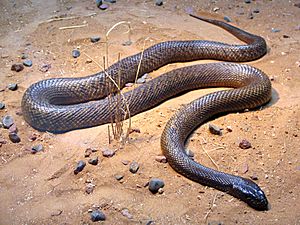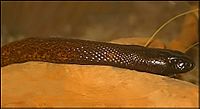Inland taipan facts for kids
Quick facts for kids Inland taipan |
|
|---|---|
 |
|
| Oxyuranus microlepidotus at Australia Zoo | |
| Conservation status | |
| Scientific classification | |
| Genus: |
Oxyuranus
|
| Species: |
microlepidotus
|
 |
|
| General range of inland taipan (in red). The current, documented range of the species is more limited. | |
| Synonyms | |
The inland taipan (Oxyuranus microlepidotus) is a type of snake that lives in Australia. It is also known as the western taipan, small-scaled snake, or fierce snake. This snake is famous for having the most powerful venom of any snake in the world. It lives in the dry, central parts of Australia.
Even though its venom is super strong, the inland taipan is usually a shy snake. It prefers to hide or escape from people. It only bites if it feels threatened, is handled roughly, or can't get away. Because it lives in remote areas, it rarely meets humans. This means it's not considered the most dangerous snake overall, especially compared to other snakes that are more aggressive. The name "fierce snake" actually describes its venom, not its personality!
Contents
What's in a Name?
Aboriginal Australians have known about the inland taipan for thousands of years. They called it dandarabilla.
Western scientists first learned about this snake in 1879. Two snakes were found and named Diemenia microlepidota by Frederick McCoy. This name means "small-scaled brown snake." Later, in 1882, another snake was found and named Diemenia ferox by William John Macleay. For about 90 years, scientists didn't find any more of these snakes. It was a mystery!
Then, in 1972, the snake was "rediscovered" by scientists. They realized it was the same snake as the "taipan" (Oxyuranus scutellatus). So, they decided to put both snakes in the same group, called Oxyuranus. The name Oxyuranus microlepidotus became the official scientific name. Oxyuranus comes from Greek words meaning "sharp arch," and microlepidotus means "small-scaled."
Where Does the Inland Taipan Live?
The inland taipan lives in the dry, flat areas of central Australia. These areas are mostly in Queensland and South Australia. It likes places with black soil plains.
You can find them in national parks like Diamantina National Park in Queensland. In South Australia, they live in areas like Goyder Lagoon and the Tirari Desert. There's also a small group of them near Coober Pedy.
Long ago, some inland taipans were found further south in Victoria and New South Wales. But they haven't been seen there since the 1880s.
Is the Inland Taipan Endangered?
Like all Australian snakes, the inland taipan is protected by law.
Experts looked at the snake's numbers in 2017. They decided it was of "least concern" for extinction. This means there are enough of them, and their numbers are not going down. However, scientists still need to study if local threats affect them.
Here's how different Australian states see its status:
- South Australia: Least concern.
- Queensland: Least concern (it used to be considered "rare").
- New South Wales: Thought to be extinct there, as it hasn't been seen in a long time.
- Victoria: Also thought to be "regionally extinct" in that state.
Where Can You See Them?
You can see inland taipans in several zoos and reptile parks. In Australia, they are at:
- Adelaide Zoo
- Taronga Zoo in Sydney
- Australia Zoo
- Australian Reptile Park
- Billabong Sanctuary
- Cairns Tropical Zoo
- Lone Pine Koala Sanctuary
- Shoalhaven Zoo
Outside Australia, you can find them in zoos in:
- Russia (Moscow Zoo)
- United States (Reptile Gardens, Kentucky Reptile Zoo, Animal World & Snake Farm Zoo)
- Europe (Skansen Zoo, Universeum, London Zoo, and others)
- Asia (Singapore Zoo)
In New South Wales, owning an inland taipan as a pet is only allowed if you have a special, high-level license for venomous reptiles.
What Does the Inland Taipan Look Like?
The inland taipan is usually dark tan. Its color can change from a rich dark brown to a brownish light green. This depends on the season. Its back, sides, and tail can have different shades of brown and grey. Many of its scales have a wide, dark edge. These dark scales form broken patterns that look like arrows pointing backward.
Its head and neck are often darker than its body. They can be glossy black in winter or dark brown in summer. This darker color helps the snake warm up by showing only a small part of its body at its burrow entrance. Its eyes are a normal size with dark brown centers.
The snake usually grows to about 1.8 meters (about 6 feet) long. Some larger ones can reach 2.5 meters (about 8 feet). Its fangs are between 3.5 and 6.2 millimeters long.
How Does Its Color Change?
Inland taipans change their skin color with the seasons. They become lighter in summer and darker in winter. This helps them control their body temperature. Darker colors absorb more heat from the sun in colder months.
Reproduction and Life Cycle
Inland taipans lay clutches of 1 to 2 dozen eggs. The eggs hatch in about two months. They usually lay their eggs in old animal burrows or deep cracks in the ground. How many eggs they lay depends on how much food is available. If there isn't enough food, they reproduce less.
In zoos, these snakes usually live for 10 to 15 years. One inland taipan at the Australia Zoo lived to be over 20 years old!
What Do Inland Taipans Eat?
In the wild, the inland taipan eats only mammals. It mostly hunts rodents, like the long-haired rat and the plains rat. It also eats introduced house mice.
Unlike many other venomous snakes that bite once and wait, the inland taipan bites its prey many times. It strikes very quickly and accurately. It can deliver up to eight venomous bites in one attack! It often snaps its jaws to make many punctures. Sometimes, it holds its prey with its body and bites it repeatedly. This injects a lot of its powerful venom deep into the prey. The venom works so fast that the prey doesn't have time to fight back.
Who Hunts the Inland Taipan?
The mulga snake (Pseudechis australis) is immune to most Australian snake venoms. It is known to eat young inland taipans. The perentie (Varanus giganteus), a large monitor lizard, also lives in the same areas. When it gets big enough, it will hunt and eat large venomous snakes like the inland taipan.
How Do Inland Taipans Interact with Humans?
Many zookeepers say the inland taipan is a calm snake to handle.
Most people rarely see inland taipans in the wild. This is because they live in remote places and don't spend much time above ground during the day. If you are quiet and don't make much noise, the snake might not feel bothered by your presence. However, it's always important to be careful and keep a safe distance.
The inland taipan will defend itself if it feels threatened. It will strike if provoked, handled roughly, or if it can't escape. First, it might make a warning display. It raises its front body in a low S-shape with its head facing the threat. If you ignore this warning, it will strike. It is extremely fast and accurate. It almost always injects venom when it bites.
Scientists have reported 11 cases of people being bitten by inland taipans. Only 2 of these bites were from wild snakes. If someone is bitten, getting antivenom quickly is very important. Getting to a hospital fast, especially by air, can greatly improve the outcome.
Stories of Snakebite Victims
In 1967, a tour guide was bitten while trying to catch a snake. He survived without antivenom, but it was a very difficult recovery. The snake was later identified as an inland taipan.
In 1984, a scientist named Peter Mirtschin was bitten by a baby inland taipan. He was the first person to be treated with taipan antivenom.
In 2012, a teenage boy was bitten on the finger by an inland taipan in a town far from its natural home. He quickly put a bandage on his arm, and doctors gave him antivenom. This saved his life. Police believed the snake was likely an illegal pet.
In 2013, a reptile handler named Scott Grant was bitten during a show. He quickly bandaged his arm. But a few minutes later, he was convulsing. He was flown to a hospital and recovered. Only a tiny amount of venom entered his body. His severe reaction was likely an allergy from past snake bites.
Almost all people bitten by inland taipans have been snake experts. These include people who study snakes, catch them for venom, or work in zoos. All of them have been treated successfully with antivenom. No deaths have been recorded since specific antivenom became available. However, it can take weeks to recover from such a serious bite.
The Inland Taipan's Venom
The inland taipan's venom is incredibly powerful. On average, it delivers about 44 milligrams of venom in a bite. The most ever recorded was 110 milligrams.
This snake's venom is the most toxic of any snake in the world. It is much more powerful than even sea snakes. Just one bite has enough venom to kill more than 100 adult humans. The inland taipan hunts mammals, so its venom is specially designed to kill warm-blooded animals.
The venom contains several types of toxins:
- Neurotoxins: These affect the nervous system and can cause paralysis or muscle weakness.
- Hemotoxins: These affect the blood, making it hard for blood to clot. This can lead to bleeding.
- Myotoxins: These damage muscles.
- Hyaluronidase enzyme: This helps the venom spread faster through the body.
One of the neurotoxins, called paradoxin (PDX), is one of the most powerful toxins ever found. It stops nerve signals from reaching muscles.
If a person is bitten and not treated, the chances of death are very high, over 80%. The venom can cause many problems in the body. These include:
- Headache, nausea, vomiting, stomach pain, dizziness.
- Paralysis, starting with drooping eyelids and difficulty speaking. This can lead to breathing problems and suffocation.
- Blood clotting issues, which can cause serious internal bleeding.
- Muscle damage, which can harm the kidneys.
Because the venom works so fast, it can kill a person in about 45 minutes. Some people have shown effects within half an hour. Getting antivenom quickly is vital to prevent these serious problems.
Antivenom for Inland Taipan Bites
Before 1955, there was only one type of antivenom for Australian snakes. It helped against many dangerous snakes, but not perfectly. Later, specific antivenoms were made for different snakes, including the coastal taipan. Finally, a general antivenom was created for any unidentified snake bite in Australia.
The antivenom made for the coastal taipan also works against the inland taipan's venom. However, it's not quite as effective for inland taipan bites.
This important antivenom is made in Australia by the Australian Reptile Park and the Commonwealth Serum Laboratories.
Images for kids
-
Oxyuranus microlepidotus at Australia Zoo
See also
 In Spanish: Taipán del interior para niños
In Spanish: Taipán del interior para niños






